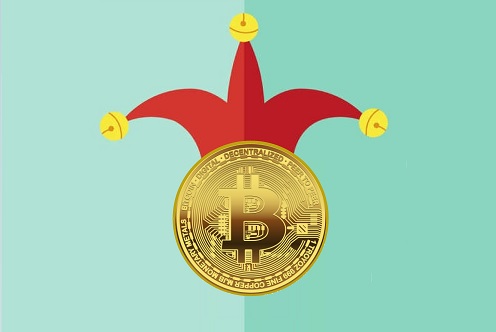
Michael Sonnenshein, managing director of Grayscale Investments, said:
“I think they understand today that buying Bitcoin and putting it in their portfolio is meant to be a store of value, inflation hedge, a digital gold, a digital form of money that is much better suited to the digital world we live in today versus historical stores of value like gold which would have been certainly much more applicable to a world characterized by physical exchanges. They view it as one of the most important next steps in the evolution of money and what constitutes a store of value.“
Let’s see the above, point by point…
1. Store of value: Tell this, when in a few days, bitcoin will collapse again. Store of value, with tremendous volatility, does not fit.
2. Inflation hedge: First, if it is inflation hedge, then why the people of Countries with big / huge inflation, haven’t adopt it? It’s not a yesterday’s product; it’s an 11 year. Second, what hedge, if you buy it at some levels and after a while, drop a 40%? This is not hedging; this is nonsense.
3. Digital gold: Really? … Gold, has uses in Jewellery Dentistry and Medicine, Electronics and Computers, Medals for sport games that give to 1st winners, in religious Statues and Idols, in details in construction of luxury buildings, in painting with gold plated paint, in gastronomy with gold flakes etc. But what are the uses of bitcoin? None. Where the bitcoiners compare bitcoin with gold, is as “store of value”. But this point, has already been answered. (see 1)
4. Digital form of money: There are better alternative digital forms of money, like ETH as many crypto-experts say. But no cryptocurrency can be mainstream and e.g. replace dollar as the main world-currency / money; it can exist only in side-line.
As we can read in cointelegraph.com/bitcoin-for-beginners/what-can-i-buy-with-bitcoins,
… it seems that Bitcoin as a payment service was doomed from the very beginning, as its underlying blockchain technology simply can’t scale to compete with industry giants such as Visa, MasterCard and PayPal.
The main problem is the amount of transactions that the network is able to process. Bitcoin’s absolute maximum capacity is a mere 7 transactions per second (tps), while Visa easily handles an average of 150 mln transactions every day, and is capable of facilitating 24,000 tps.
As more and more people started using Bitcoin and sending transactions, the network became bloated. Along with the amount of transactions, the waiting times and, most importantly, transaction fees have skyrocketed.
According to blockchain.info’s data, the average waiting time in winter 2018 was in the region of hours, in some extreme cases – hundreds, sometimes even thousands of hours. The graph peaked on Jan. 23 at an astronomical number of 11,453 minutes – almost 20 days.
It is worth noting that such excessive waiting times were most likely associated with microscopic transactions sent through with tiny transaction fees, if any at all. So, miners simply avoided confirming such transactions as it would be a waste of time and resources for them.
Still, for the transaction to go through as quickly as possible, users had to pay massive amounts of fees so that miners will actually confirm them. According to BitInfoCharts, at one point during the winter period users had to pay an average of $55 to see their transaction go through (see graph 1, below).
Quite obviously, no one is going to use Bitcoin to buy a $3 dollar cup of coffee and have to pay 15 times that amount in fees and wait for a couple of hours until transaction is confirmed. But still, stating that ‘we accept Bitcoin’ is still a very useful PR stunt for businesses.
However, as of now Bitcoin seems to have gone over its winter crisis. The waiting times returned to a 10-30 minutes mark and the transaction fees dropped back to quite lower levels. For now.

After the last collapse that followed the 2017 peak at ~20,000 USD, damage was done to bitcoin. As a result of the collapse, several high-profile service providers and retails stopped accepting bitcoin as a form of payment. Here’s a small example of the largest companies:
• Dell — They were the biggest company to support BTC payments, but dropped the option due to low demand.
• Steam — They used to accept BTC for game purchases, but stopped doing so citing high transaction fees and incredible volatility as the reasons to doing so.
• Fiverr — This freelance marketplace stopped accepting BTC for the same reason Dell did – lack of interest in the option.
• Stripe — A payment processor for businesses has recently ended support for BTC due to slow confirmation times and high fees.
—- —- —- —- —-
So, now, you understand why bitcoin will never be basic mean of transactions worldwide or even a basic alternative … and those are essential parameters and conditions to justify high prices, even more very high prices. Bitcoin’s construction does not allow to become a basic mean of money/transaction worldwide, even alternative, and not mainstream.
In previous bitcoin’s skyrocketing that ended at its historical high price (~20,000 USD) at December 2017, there was a huge speculation that fueled it’s upswing but this ‘noise’ and promotion by the media references, brought also relatively enough real users, that’s why the bitcoin’s transaction fee peaked also at ~55 USD (graph 1); the recent bitcoin’s skyrocketing of the October, November 2020, is fueled even more from speculators, and that is revealed by the transaction fee (that has to do with the real use of bitcoin), which as you can see is only at 2.83 USD today (graph 2). So, no real use supports the recent upswing < driven by speculation, even more than the late 2017, and that’s why bitcoin will very soon, collapse again.
Panayotis Sofianopoulos
Author of :
Bitcoinvest or Not? Answers to Crucial Questions.
…for those, considering investing in bitcoin and other cryptos too.
Bilingual book (English and Greek)
Για αυτούς που σκέφτονται να επενδύσουν στο BTC ή και σε άλλα cryptos.
Επίσης, για όσους ενδιαφέρονται, μπορούν να αναζητήσουν το webinar, με τίτλο



